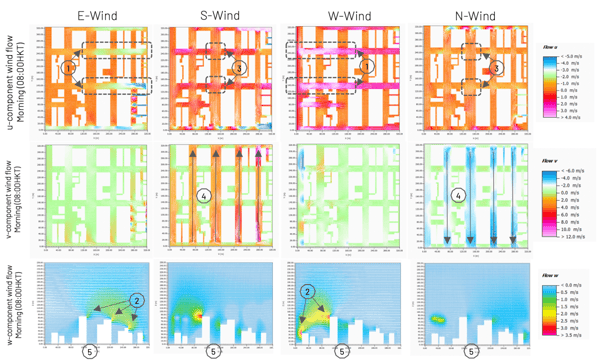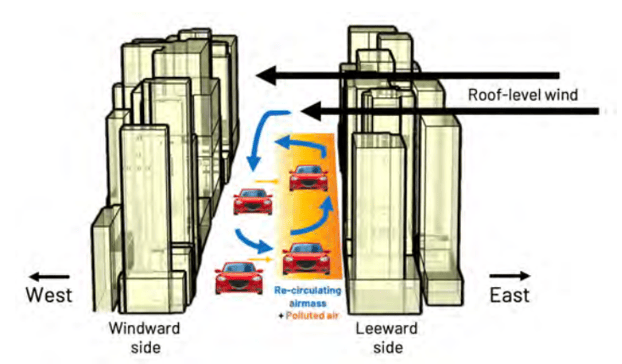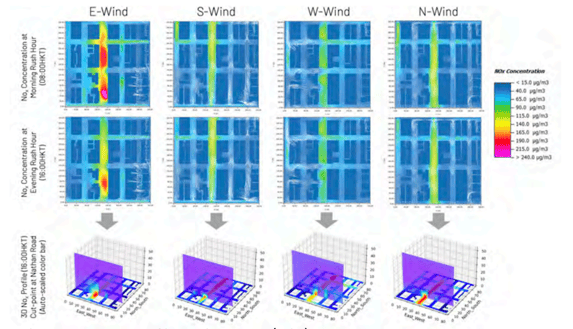Jeffrey Chang, a PhD candidate at The University of Hong Kong, employs ENVI-met software to analyze how wind dynamics and urban design influence pollution levels in Hong Kong's densely built street canyons. His study, set in Mong Kok — one of the city's most compact districts — investigates the interactions between wind flow, building geometries, and vehicle emissions that lead to localized air quality challenges.
Listen to the article

Air pollution has become one of the most pressing environmental and health issues for cities worldwide. According to the World Health Organization (WHO), nearly 90% of urban areas exceed the recommended air quality standards for pollutants like nitrogen dioxide (NO2) and particulate matter (PM2.5), which are linked to health issues such as heart disease, lung cancer, and respiratory disorders. In fact, the State of Global Air Report 2024 that 8.1 million deaths were attributed to air pollution globally in 2021, with the greatest health impacts occurring in cities across Asia, Africa, and Eastern Europe.
Given the severity of air pollution's impact, understanding its causes and finding effective solutions are essential. This is particularly important in high-density cities, where pollution levels tend to be higher. One such city is Hong Kong, where street canyons play a significant role in trapping pollutants.
What are street canyon effects?
Street canyons are a defining feature of many megacities, including Hong Kong. These urban formations create microclimates where airflow is restricted by closely packed, tall buildings. As a result, vehicular emissions — especially NOx — become trapped, leading to localized pollution hotspots.
In Mong Kok, one of the city’s busiest and most compact neighborhoods, this effect is especially pronounced. Stagnant wind conditions and high traffic volumes worsen air quality, exposing residents and pedestrians to elevated levels of pollutants and increasing risks of respiratory and cardiovascular diseases.

Image source: Jeffrey Chang
By using ENVI-met, a microclimate simulation tool, the study analyzed how factors such as wind direction, speed, and urban geometry influence NOx dispersion over the course of a day.
Findings from ENVI-met wind simulations
ENVI-met's wind modeling capabilities provided detailed insights into how street canyons influence air quality:
- Wind direction governs pollutant dispersion: Winds blowing across the street canyon (from east or west) create swirling air that traps pollutants close to the ground, causing higher concentrations in certain areas. In contrast, winds blowing along the canyon (from north or south) help move pollutants through the street, spreading them more evenly and reducing buildup in one spot.

- Building geometry affects airflow: The study showed that the height and arrangement of buildings influence how wind moves through the canyon. Taller buildings on the side facing the wind create areas of still air where pollutants can gather, while buildings on the opposite side can block the wind from flowing freely. This interaction between buildings and wind can cause higher pollutant levels at street level and on lower floors of buildings.

- Pollution spreads vertically: While most studies focus on ground-level exposure, Chang’s simulations showed that pollutants such as NOx can travel upward to mid-levels of buildings, with concentrations rising as high as 10 meters. This is particularly relevant for residents living in multi-story buildings, who may be exposed to elevated pollutant levels despite being several floors above street level.

Applications for urban planning & public health
Chang’s study offers valuable insights for urban planners and policymakers working to reduce pollution in dense cities. By understanding the impact of building design and traffic flow on air circulation, planners can optimize urban layouts to prevent the accumulation of harmful pollutants. For example, designing buildings to improve airflow or adjusting traffic patterns to reduce congestion can help disperse pollutants, leading to cleaner air. Identifying pollution hotspots, where stagnant air and high emissions converge, allows cities to focus on targeted interventions, such as incorporating green infrastructure or redesigning roads for better traffic management.
The role ENVI-met in tackling urban air pollution
The study showed that stagnant air could worsen pollution risks in dense urban environments like Hong Kong’s street canyons, trapping harmful emissions such as NOx and particulate matter. This leads to localized hotspots with elevated pollution levels. Optimized airflow, on the other hand, can help disperse pollutants, reduce exposure, and improve air quality.
ENVI-met’s high-resolution simulation capabilities are crucial in understanding these complex interactions. The software’s three-dimensional wind flow model can simulate air movement around buildings, identifying areas with high wind speeds and turbulence and regions with low wind speeds and stagnating air masses. This allows urban planners to pinpoint pollution hotspots and evaluate potential interventions, such as modifying building layouts or incorporating green facades to improve airflow. By analyzing these factors, ENVI-met helps city planners design environments that mitigate air pollution and promote healthier spaces.
Carbon Experts Newsletter
Industry news & insights — straight to your inbox
Want to learn more?
Roberta Belanova • Nov 15 2024
Roberta Belanova • Oct 28 2024
Roberta Belanova • Oct 21 2024
